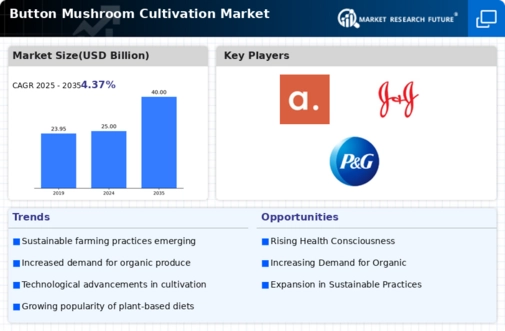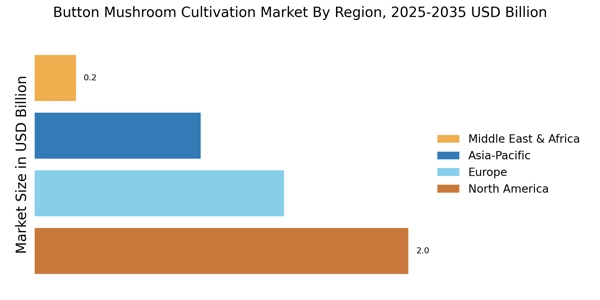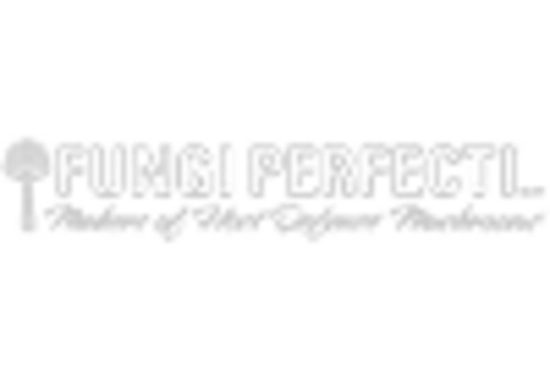Expansion of Culinary Applications
The culinary world is increasingly embracing button mushrooms, which is positively impacting the Button Mushroom Cultivation Market. Chefs and home cooks alike are discovering the versatility of button mushrooms, incorporating them into a wide array of dishes ranging from appetizers to main courses. This expansion in culinary applications is supported by market data indicating a rise in mushroom consumption in various cuisines, particularly in Asian and Mediterranean dishes. As the popularity of button mushrooms continues to grow, the demand for cultivation is likely to increase, prompting producers to enhance their cultivation techniques. This trend not only benefits the market but also encourages innovation in mushroom-based products, such as sauces and snacks, further solidifying the position of button mushrooms in the food industry.
Increasing Demand for Organic Produce
The Button Mushroom Cultivation Market is experiencing a notable surge in demand for organic produce. Consumers are increasingly prioritizing health and wellness, leading to a preference for organic mushrooms over conventionally grown varieties. This trend is supported by data indicating that organic food sales have consistently outpaced conventional sales in recent years. The rise in health consciousness among consumers is driving this demand, as organic mushrooms are perceived to be free from harmful pesticides and chemicals. Consequently, mushroom cultivators are adapting their practices to meet this growing preference, which is likely to enhance the overall market landscape. As more consumers seek out organic options, the Button Mushroom Cultivation Market is poised for growth, with cultivators potentially expanding their organic offerings to capture this lucrative segment.
Rising Awareness of Nutritional Benefits
The Button Mushroom Cultivation Market is benefiting from a growing awareness of the nutritional benefits associated with button mushrooms. These mushrooms are rich in essential nutrients, including vitamins, minerals, and antioxidants, which contribute to overall health. Research indicates that button mushrooms may play a role in boosting the immune system and reducing the risk of chronic diseases. As consumers become more informed about the health advantages of incorporating mushrooms into their diets, the demand for button mushrooms is likely to rise. This trend is prompting cultivators to emphasize the health benefits of their products, potentially leading to increased marketing efforts and educational campaigns. The heightened focus on nutrition is expected to drive growth in the Button Mushroom Cultivation Market, as more individuals seek to enhance their diets with nutrient-dense foods.
Growing Interest in Sustainable Farming Practices
Sustainability is becoming a focal point within the Button Mushroom Cultivation Market, as consumers increasingly demand environmentally friendly farming practices. The cultivation of button mushrooms is inherently more sustainable compared to other agricultural practices, as mushrooms can be grown on agricultural waste and require less water and land. This aligns with the global push towards sustainable food production, which is supported by data indicating that consumers are willing to pay a premium for sustainably sourced products. As awareness of environmental issues grows, cultivators are likely to adopt more sustainable practices, such as organic farming and waste recycling, to meet consumer expectations. This shift not only enhances the market appeal of button mushrooms but also contributes to the overall sustainability of the agricultural sector, potentially leading to increased market share for environmentally conscious producers.
Technological Innovations in Cultivation Techniques
Technological advancements are playing a crucial role in shaping the Button Mushroom Cultivation Market. Innovations in cultivation techniques, such as automated growing systems and climate control technologies, are enhancing productivity and efficiency in mushroom farming. These advancements allow cultivators to optimize growing conditions, resulting in higher yields and improved quality of button mushrooms. Data suggests that the adoption of such technologies can lead to a significant reduction in production costs, making mushroom cultivation more economically viable. As the industry continues to embrace these innovations, it is likely to attract new entrants and investment, further stimulating growth in the Button Mushroom Cultivation Market. The integration of technology not only benefits existing cultivators but also paves the way for sustainable practices that align with consumer preferences.


















Leave a Comment